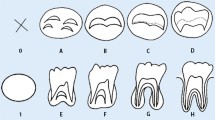Abstract
In order to study the chronology of age of third molar mineralization of Han in southern China, Demirjian staging method was used to determine the stage of four third molars (18, 28, 38, 48) mineralization in 3,100 Han in southern China aged 4.1–26.9 years based on radiological evidence from digital orthopantomograms. The mean age of the 3,100 patients was 15.96 ± 4.73 years, including 1,200 male (mean age, 15.32 ± 4.62) and 1,900 female (mean age, 16.35 ± 4.76). Results show that there was no significant difference in mineralization between 18 and 28 and 38 and 48 of male or female. However, significant difference was observed between 28 and 38 of female at stage C; 28 was 0.25 years earlier than 38. In male, at stage G, 38 was 0.61 years earlier than 28, and 48 was 0.62 years earlier than 18. At stages D, E, F, G, and H, male 48 was 0.34, 0.66, 0.72, 1.34, and 0.76 years earlier than that of female, respectively. At stages A, D, E, F, G, and H, male 38 was 0.73, 0.26, 0.56, 0.91, 1.29, and 0.70 years earlier than that of female, respectively. At stages B, E, F, G, and H, the mineralization mean age of male 18 was 0.54, 0.50, 0.76, 0.92, and 0.58 years earlier than that of female, respectively. At stages E, F, G, and H, the mineralization mean age of male 28 was 0.51, 0.76, 0.92, and 0.49 years earlier than that of female, respectively. After reviewing the literature, the chronological mineralization age of 48, at stages D to G, of Han in southern China was 1 to 4.6 years earlier than that of Japanese and 1 to 3 years earlier than that of German. The mean age at stage H of 48 of Han in southern China was similar to Turkish, Black African, Japanese, and German, but was later than Spanish. Finally, the conclusions are: (1) in the same gender group of Han in southern China, the mineralization ages between two sides in upper or lower jaw are very similar, and (2) the chronology mean age and complete time of third molar mineralization of male were earlier than that of female.
Similar content being viewed by others
References
Greulich WW, Pyle SI (1959) Radiographic atlas of skeletal development of the hand and wrist. Stanford University Press, CA
Kreitner KF, Schweden FJ, Riepert T, Nafe B, Thelen M (1998) Bone age determination based on the study of the medial extremity of the clavicle. Eur Radiol 8:1116–1122
Tanner JM, Whitehouse RH, Marshall WA, Healy MJR, Goldstein H (1975) Assessment of skeletal maturity and prediction of adult height (TW2 method). Academic, London
Mornstad H, Pfeiffer H, Teivens A (1994) Estimation of dental age using HPLC-technique to determine the degree of aspartic acid racemization. J Forensic Sci 39:1425–1431
Nambiar P, Jaacob H, Menon R (1996) Third-molars in the establishment of adult status—a case report. J Forensic Odontostomatol 14:30–33
Sisman Y, Uysal T, Yagmur F, Ramoglud SI (2007) Third-molar development in relation to chronologic age in Turkish children and young adults. Angle Orthod 77(6):1040–1045
Kullman L (1995) Accuracy of two dental and one skeletal age estimation method in Swedish adolescents. Forensic Sci Int 75:225–236
Olze A, van Niekerk P, Schmidt S, Wernecke KD, Rösing FW, Geserick G, Schmeling A (2006) Studies on the progress of third-molar mineralization in a Black African population. Homo 57(3):209–217
Olze A, Taniguchi M, Schmeling A, Zhu B-L, Yamada Y, Maeda H, Geserick G (2003) Comparative study on the chronology of third molar mineralization in a Japanese and a German population. Leg Med 5(Suppl 1):S256–260
Olze A, Taniguchi M, Schmeling A, Zhu B-L, Yamada Y, Maeda H, Geserick G (2004) Studies on the chronology of third molar mineralization in a Japanese population. Leg Med 6(2):73–79
Demirjian A, Goldstein H, Tanner JM (1973) A new system of dental age assessment. Hum Biol 45(2):221–227
Prieto JL, Barbería E, Ortega R (2005) Evaluation of chronological age based on third molar development in the Spanish population. Int J Legal Med 119:349–354
Schmeling A, Grundmann C, Fuhrmann A, Kaatsch HJ, Knell B, Ramsthaler F, Reisinger W, Riepert T, Timme SR, Rösing FW, Rötzscher K, Geserick G (2008) Criteria for age estimation in living individuals. Int J Legal Med 122:457–460
Schmidt S, Nitz I, Schulz R, Schmeling A (2008) Applicability of the skeletal age determination method of Tanner and Whitehouse for forensic age diagnostics. Int J Legal Med 122:309–314
Gleiser I, Hunt EE (1955) The permanent mandibular first molar: its calcification, eruption and decay. Am J Phys Anthropol 13:253–284
Moorrees CFA, Fanning EA, Hunt EE (1963) Age variation of formation stages for ten permanent teeth. J Dent Res 42:1490–1502
Kullman L, Johanson G, Akesson L (1992) Root development of the lower third molar and its relation to chronological age. Swed Dent J 16:161–167
Kvaal SI, Kollveit KM, Thomsen IO, Solheim T (1995) Age estimation of adults from dental radiographs. Forensic Sci Int 74:175–185
Paewinsky E, Pfeiffer H, Brinkmann B (2005) Quantification of secondary dentin formation from orthopantomograms. A contribution to forensic age estimation methods in adults. Int J Legal Med 119:27–30
Landa MI, Garamendi PM, Botella MC, Alemán I (2009) Application of the method of Kvaal et al. to digital Orthopantomograms. Int J Legal Med 123:123–128
Olze A, Bilang D, Schmidt S, Wernecke KD, Geserick G, Schmeling A (2005) Validation of common classification systems for assessing the mineralization of third molars. Int J Legal Med 119:22–26
Author information
Authors and Affiliations
Corresponding author
Rights and permissions
About this article
Cite this article
Zeng, D.L., Wu, Z.L. & Cui, M.Y. Chronological age estimation of third molar mineralization of Han in southern China. Int J Legal Med 124, 119–123 (2010). https://doi.org/10.1007/s00414-009-0379-y
Received:
Accepted:
Published:
Issue Date:
DOI: https://doi.org/10.1007/s00414-009-0379-y




